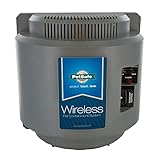
One of the most important aspects of having an invisible or wireless fence for your dog is training them. After all, most people who say that invisible fences do not work are those that either rushed their dogs training or offered no training whatsoever.
By spending less than an hour a day working with your dog to establish the boundaries of your home you are ensuring the success of an invisible fence. This training is a small price to pay when you look at the benefits of having an invisible fence for your dog and is often completed within a month.
The Goal of Training
The main goal of training your dog to respect the boundaries of your wireless or invisible fencing is so that you can keep your dog safely contained on your property or part of it. Without training, your dog will not know where the boundaries are, why his collar is beeping him, and why he is getting a shock.
This is unfair to him. When used properly with proper training very few people have issues with their dogs running through the fence, even those who are known for wandering. They have shown to be more effective in some ways than standard fencing at a fraction of the cost and without any visual disturbances.
The Training Schedule
Training should be done one to two times a day for ten to fifteen minutes a session. Keeping these sessions short and fun will not only keep your dog happy, but they will also learn faster and retain the information easier.
A good time to work on training is after their morning walk or in the afternoon. Do not attempt training sessions when they are wound up, waiting for dinner, or have other distractions such as children coming home from school. A little planning is the foundation required to set your dog up for success.
Phase One: Boundary Awareness
In your wireless or invisible fencing kit, there will be a set of flags. These are essential to your dog’s training as they give the visual markers that your dog will need to know where the fence is. Without these, your dog will have a much harder time determining what his boundaries are, and, therefore, he is less likely to succeed.
Lead your dog near the boundary on a leash attached to a non-metallic flat collar that is placed above the invisible fencing collar. Allow the dog to walk up towards the flag but when the beeping is heard lead your dog back into the safe zone quickly. Praise him for coming back and continue this until he learns to come back as soon as he hears the beeping.
Phase Two: Introducing the Static Correction
After your dog is familiar with the beeping and returning to the safe zone, you can introduce your dog to the static correction. This does not mean that you are to drag your dog to the fence and let him get a shock. This would be detrimental to his training. Instead, allow your dog to inspect the boundary line in the same way you did previously but instead of leading him back to the safe zone this time, allow him to venture further to experience the correction. Lead your dog quickly back to the safe zone and praise him for coming back.
Often dogs will learn to avoid the correction within a couple of days although if you have a larger dog that appears unaffected you may want to move on to a collar that offers slightly more voltage to get his attention.
Phase Three: Temptations and Distractions
Once your dog avoids the correction zone consistently, which often takes less than five days, you can introduce distractions and temptations. You can move training time to the afternoon when your children are coming home from school, or when someone is walking their dog by your home. You can also place toys outside of the safe zone to try to tempt him to cross the line.
Praise your dog every time they ignore these temptations and when they turn away from the boundary line.
Phase Four: Off Leash Supervision
Depending on how stubborn your dog is or how easily distracted they are they should be ready for off leash supervision relatively quickly. Pick a time when you can be out in the yard with them. Make sure you have their leash on hand in case they try to run. You can play with them, read a book, work on your gardening or other tasks as long as you are in the yard with them.
When they turn away from the boundary line on their own, praise them and let them know you are proud of them.
Phase Five: Relaxed Monitoring
When you are comfortable with the dog being in the yard without a leash on for a minimum of 5 days, you can be much more relaxed with your monitoring. You can go about your daily tasks in the yard or the home as long as you check on them fairly regularly to ensure that they are doing fine in the yard.
Once this has been well established, you can remove every other flag once a week until there are no fences left. This gives your dog time to learn their landmarks on where the fence lies and allows you to have a completely invisible fence line that will keep your dog safely confined.
Video Tutorial for Training your Dog
This video by PetSafe gives you step-by-step guide with tips and troubleshooting for training your dog to understand and respect your wireless dog fence.














